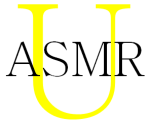 Beverley Fredborg, James Clark, and Stephen Smith have published another ASMR research study titled, “Mindfulness and ASMR.” The study was published August 7, 2018 in PeerJ.
Beverley Fredborg, James Clark, and Stephen Smith have published another ASMR research study titled, “Mindfulness and ASMR.” The study was published August 7, 2018 in PeerJ.
The goal of this study was to investigate the potential relationships between ASMR and mindfulness.
In their introduction, they provide these descriptions of mindfulness:
- “…a two-component process by which one engages in both intentional self-regulation of attention and a nonjudgmental awareness and acceptance of the present moment.”
- “…involves an openness to sensations, attentional control, emotional regulation, and resilience.”
The authors then highlight the similarities between mindfulness and ASMR:
- “…the focused attention method of mindfulness meditation requires individuals to focus on a specific external stimulus or internal thought…During ASMR experiences, individuals focus attention on an external stimulus that triggers tingling sensations.”
- “Both mindfulness and ASMR can lead to a feeling of relaxation that enhances people’s subjective well-being.”
These similarities definitely make one wonder if mindfulness is a form of ASMR, if ASMR is a form of mindfulness, or is there some other relationship?
The authors also teased out more data about ASMR and trigger preferences, age of onset, similarity to music chills, and frequency of using ASMR media to help with relaxation and sleeping.
The study involved 284 ASMR-responders and 279 ASMR-non-responders (controls). ASMR-responders were recruited from an online ASMR community and the ability to experience ASMR was self-reported and also involved the completion of an ASMR checklist. ASMR-non-responders (controls) were determined by absence of ASMR in the past and the absence of tingling sensations after watching ASMR videos provided by the researchers. The average age of all of the participants was about 28 years and about 54% were female.
The ASMR-responder group and the control group completed several standardized scales and questionnaires about mindfulness and ASMR via an online survey.
Toronto Mindfulness Scale (TM scale)
- Decentering subscale
- results were inconclusive
- Curiosity subscale
- The ASMR-responders had higher scores than the control group.
- ASMR-responder females scored higher than ASMR-responder males (no difference seen for gender in control group).
Mindful Attention Awareness Scale (MAA scale)
- The ASMR-responders had higher scores than the control group.
- No gender differences were measured.
ASMR Checklist vs Mindfulness Scales
- The intensity of ASMR due to Touching stimuli or Repetitive Sound stimuli correlated with the mindfulness rating of the TM curiosity subscale.
- The intensity of ASMR due to Simulations stimuli correlated positively with the mindfulness rating of the MAA scale.
ASMR Checklist – other measures specific to the 248 ASMR-responders
- ASMR vs Frisson/Chills:
- 87% experience chills from music
- 91% indicated that ASMR and chills from music feel differently
- Note: Frisson correlated positively with TM curiosity subscale
- “How pleasurable is an ASMR experience”:
- “quite pleasurable” (76%)
- “mildly pleasurable” (23%)
- “neutral” (<1%)
- “mildly uncomfortable”,(<1%)
- “quite uncomfortable” (<1%)
- Note: Increasing tingle intensity correlated positively with increasing pleasurable
- Note: Tingle pleasure correlated positively with TM curiosity subscale
- “How often do you use ASMR videos or audio files to help you to relax (but not sleep)?”
- never (5%)
- <1x/month (7%)
- 1x/month (5%)
- 2-3x/month (9%)
- 1x/week (14%)
- 2-3x/week (33%)
- daily (28%)
- Note: Modest positive correlation between frequency and tingle intensity
- Note: No strong correlations between frequency and mindfulness scales
- “How often do you use ASMR videos or audio files to help you to sleep?”
- never (10%)
- <1x/month (7%)
- 1x/month (3%)
- 2-3x/month (12%)
- 1x/week (10%)
- 2-x/week (29%)
- daily (30%)
- Note: data from supplemental file
- “Are your ASMR experiences more intense when..
- …the stimulation is directed toward you?”
- Yes (78%)
- No (14%)
- Unsure (7%)
- …you observe someone performing an action to/for themselves?”
- Yes (23%)
- No (48%)
- Unsure 30%)
- Note: data from supplemental file
- …the stimulation is directed toward you?”
- “What is the earliest age you can recall having an ASMR experience? ”
- Average = 8.6 years
- Median = 8 years
- 0-8 years old: 59%
- 0-10 years old: 73%
- 0-12 years old: 83%
- 0-18 years old: 97%
- Note: data from supplemental file
Summary
The study supports that mindfulness and ASMR are related. Individuals who experience ASMR are more likely to possess the attentional component of mindfulness (MAA scale), and have a greater interest in their own conscious experiences (TM curiosity subscale).
The authors highlight that these findings support the possibility that mindfulness training could enhance the effects of ASMR and therefore enhance the potential benefits of ASMR for relaxation, sleep, low mood, and associated clinical conditions.
Additional important findings of this study are that the majority of ASMR-responders:
- believe ASMR and music chills are different responses
- find ASMR quite pleasurable which correlates with increased tingle intensity
- use ASMR videos or ASMR audio to help them relax and sleep several times a week or daily
- have more intense ASMR when a simulation is directed towards them rather than away from them
- recall their first ASMR experience occurred in childhood
Click HERE to read the full research manuscript.
Click the links below to learn more about ASMR research:
- Tips: How to be an ASMR researcher.
- Insight: Interviews with ASMR researchers.
- Browse: ASMR research and publications.
Want to be alerted of new blog articles, and/or new podcast episodes? Enter your email into the ***SAVE TIME*** widget (located in the sidebar or footer area).
Scroll down to Print, Share, Reblog, Like, Jump to related posts, or Comment.
This post brought to you by ASMR University. A site with the mission of increasing the awareness, understanding, and research of the Art and Science of Autonomous Sensory Meridian Response.